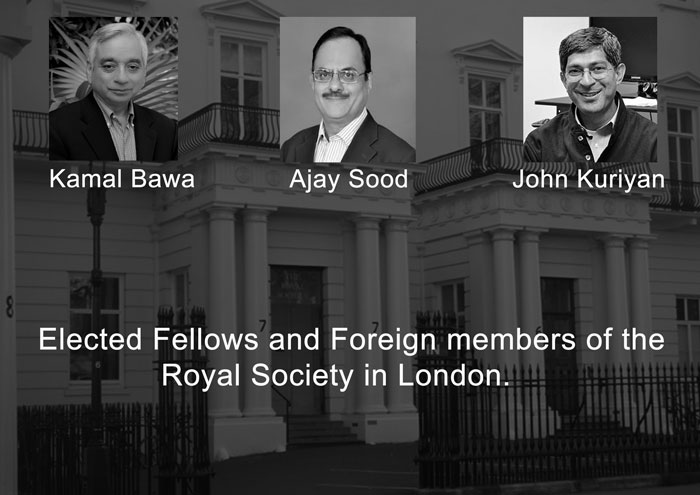Noted scientists of Indian origin, Kamal Bawa, Ajay Sood and John Kuriyan have recently been elected as Fellows and Foreign member of the Royal Society in London. They are expected to be formally admitted to the Royal Society on 10th July 2015. The Bangalore Biocluster campus extends its warm congratulations to these luminaries.
Fellows are elected to the Royal Society and include the most eminent scientists, engineers and technologists in the UK and Commonwealth countries. This is an institution which has now been in existence for over three centuries and previously included scientists such as Sir Isaac Newton and Sir Alexander Fleming. There are approximately 1,600 Fellows and Foreign Members, including around 80 Nobel Laureates. Current Fellows include Richard Dawkins, Stephen Hawking, Paul Nurse and John Sulston. Current Indian Fellows include Raghunath Mashelkar and Roddam Narasimha.
Bawa, Distinguished Professor of Biology, University of Massachusetts-Boston, is one of forty-seven new Fellows elected to the Royal Society this year. He is an evolutionary ecologist and a prominent conservation biologist. "Prof. Kamal Bawa, is a pre-eminent Indian scientist who first made his mark globally, but, not being content to rest on his academic laurels, chose to devote decades of his talent to build plant conservation models rooted in hard science but accommodating local user needs in the real world. In the process, he has nurtured multiple Indian scientific talents in and established inter-disciplinary institutions, which will sustain his conservation legacy into the future. I am delighted at this richly merited recognition", says Ullas Karanth, Director for Science-Asia, Wildlife Conservation Society, New York.
Bawa is also the founder of ATREE, an NGO that generates interdisciplinary knowledge, guides policymaking, disseminates information, and builds human capacity in biodiversity science. "ATREE, the institution that Bawa founded, has been a very active contributor to the Masters course in Wildlife Biology and Conservation that NCBS runs in collaboration with Wildlife Conservation Society. Jagdish Krishnaswamy has been a member of the Steering Committee of our Wildlife Programme, and has been offering courses in statistics and landscape ecology, since the inception of the course in 2004. These courses have been among the most popular among the students. Abi Tamim Vanak have taught carnivores ecology since 2012, and both of them have guided several Masters dissertations. In addition, several faculty from ATREE have been guest speakers. Our Masters students have also benefited from several guest talks at ATREE. ATREE and NCBS have functioned without walls in running our Masters course, reflecting Bawa's core philosophy of working together" says Ajith Kumar, Course Director of the Post-Graduate Programme in Wildlife Biology and Conservation at NCBS.
Kuriyan, Professor of Molecular and Cell Biology and of Chemistry, Howard Hughes Medical Institute, University of California, Berkeley, is one of ten new foreign members elected this year. "John Kuriyan started his undergraduate career at Madras Christian College and then won a scholarship to transfer to Juniata College in Pennsylvania. Along the way he realized that the variation in form that he so admired in animals is also present in their proteins. He figured that questions of form and function were probably better addressed with proteins than with tigers or barnacles, so he switched his major from zoology to Chemistry. His PhD dissertation on biophysical chemistry was jointly guided by Greg Petsko (MIT) and Martin Karplus (Harvard). After a short Postdoctoral stint with Karplus, he moved to Rockefeller as an Assistant Professor and went on to become one of the youngest full professors in Rockefeller history. After a stay of over a decade, he moved to Berkeley in significant part for the opportunity to teach undergraduates. His passion for teaching has resulted in an excellent text book "The Molecules of Life" co-authored with two of his colleagues.
John's research interests have focused on molecules involved in two sets of functions: replication and signal transduction. Among the highlights of his replication work is the sliding clamp - one of the more beautiful structures around - and the clamp-loader complex. His signal transduction work is more recent and perhaps more familiar here. The structures he solved showed, for the first time, how the Src kinase is allosterically regulated; elucidated how Gleevec specifically affected the BCR-Abl kinase (by binding to its inactive form); worked out how binding of ligand in the extracellular space is transduced into kinase activity in the cytosol by the EGF receptor; and figured out how CaMKII activity is dramatically altered by frequent re-stimulation, thereby solving an important element of the puzzle of how tetanic stimulation of a synapse can lead to its long term potentiation. Many of the structures he has solved are not only informative but also, like tygers in the forests of the night, strikingly beautiful " says MK Mathew, Faculty at NCBS
Upinder Bhalla, Dean, NCBS, says "We're delighted that the fine work of our oveseas colleagues John Kurian and Kamaljit Bawa have been recognized by their election to the Royal Society. In addition to being outstanding scientists, John and Kamal have made major institutional contributions especially to NCBS. They have been closely involved with the development of NCBS programmes, through their respective roles on our management board and involvement in the development of our wildlife and conservation programme.".
Other links: https://royalsociety.org/about-us/fellowship/new-fellows-2015/










0 Comments